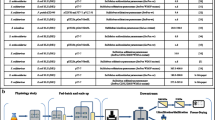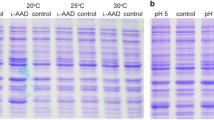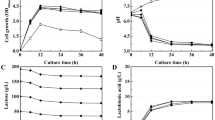Abstract
Thermostable phosphotriesterase-like lactonases (PLLs) from extremophile archaea, like SsoPox from Sulfolobus solfataricus, are attractive biotechnological tools with industrial applications as organophosphate decontaminants, but their manufacturing still remains an unresolved issue because of the high costs and the low production yields. In this paper, for the first time, an efficient biotechnological process for the production and purification of a recombinant, engineered PLL, SsoPox W263F, expressed in E. coli, has been set up by studying new induction strategies, by designing high cell density cultivations and a new membrane-based downstream process. In fed batches, the enzyme production was boosted of 69-fold up to 4660.0 U L−1 using galactose as inducer in the replacement of IPTG; the process was scalable from 2.5 up to 150 L. By coupling a single thermo-precipitation step and an ultrafiltration process, a total enzyme recovery of 77% with a purity grade of almost 80% was reached.





Similar content being viewed by others
References
Babaeipour V, Shojaosadati SA, Khalilzadeh R, Maghsoudi N, Tabandeh F (2008) A proposed feeding strategy for the overproduction of recombinant proteins in Escherichia coli. Biotechnol Appl Biochem 49:141–147. doi:10.1042/BA20070089
Bradford MM (1976) A rapid and sensitive method for the quantitation of microgram quantities of protein utilizing the principle of protein-dye binding. Anal Biochem 72:248–254
Carullo P, Cetrangolo PG, Mandrich L, Manco G, Febbraio F (2015) Fluorescence spectroscopy approaches for the development of a real-time organophosphate detection system using an enzymatic sensor. Sensors 15:3932–3951. doi:10.3390/s150203932
Carvalho RJ, Cabrera-Crespo J, Tanizaki MM, Gonçalves VM (2011) Development of production and purification processes of recombinant fragment of pneumococcal surface protein A in Escherichia coli using different carbon sources and chromatography sequences. Appl Microbiol Biotechnol 94:683–694. doi:10.1007/s00253-011-3649-9
Cha HJ, Wu CF, Valdes JJ, Rao G, Bentley WE (2000) Observations of green fluorescent protein as a fusion partner in genetically engineered Escherichia coli: monitoring protein expression and solubility. Biotechnol Bioeng 67:565–574
Cheng TC, Harvey SP, Chen GL (1996) Cloning and expression of a gene encoding a bacterial enzyme for decontamination of organophosphorus nerve agents and nucleotide sequence of the enzyme. Appl Environ Microbiol 62:1636–1641
Donovan RS, Robinson CW, Glick BR (1996) Optimizing inducer and culture conditions for expression of foreign proteins under the control of the lac promoter. J Ind Microbiol 16:145–154
Gunnell D, Eddleston M, Phillips MR, Konradsen F (2007) The global distribution of fatal pesticide self-poisoning: systematic review. BMC Public Health 7:357. doi:10.1186/1471-2458-7-357
Gupta RC (2009) Global impact of chemical warfare agents used before and after 1945. In: Gupta RC (ed) Handbook of toxicology of chemical warfare agents, 2nd edn. Accademic Press/Elsevier, New York, pp 23–24
Han L, Enfors SO, Häggström L (2003) Escherichia coli high-cell-density culture: carbon mass balances and release of outer membrane components. Bioprocess Biosyst Eng 25:205–212. doi:10.1007/s00449-002-0300-2
Hiblot J, Gotthard G, Chabriere E, Elias M (2012) Characterisation of the organophosphate hydrolase catalytic activity of SsoPox. Sci rep 2:779. doi:10.1038/srep00779
Hopkins TR (1991) Physical and chemical cell disruption for the recovery of intracellular protein. In: Seetharam R, Sharma SK (eds) Purification and analysis of recombinant proteins. Macel Dekker, New York, pp 57–84
Horne I, Qiu X, Russell RJ, Oakeshott JG (2003) The phosphotriesterase gene opdA in Agrobacterium radiobacter P230 is transposable. FEMS Microbiol Lett 222:1–8. doi:10.1016/S0378-1097(03)00211-8
Jacquet P, Daudé D, Bzdrenga J, Masson P, Elias M, Chabrière E (2016) Current and emerging strategies for organophosphate decontamination: special focus on hyperstable enzymes. Environ Sci Pollut Res. doi:10.1007/s11356-016-6143-1
Jaipieam S, Visuthismajsrn P, Sutheravut P, Siriwong W, Thoumsang S, Borjam M, Robson M (2009) Organophosphate pesticides residues in drinking water from artesian wells and health risk assessment of agricultural communities, Thailand. Hum Ecol Risk Assess Int J 15:1304–1316
Jin LH, Kwun K, Lee J (2008) Intra- and extra-cellular organophosphorus hydrolase production with recombinant E. coli using fed-batch fermentation. World J Microbiol Biotechnol 24:1657–1662. doi:10.1007/s11274-008-9679-5
Kapoor M, Rajagopal R (2011) Enzymatic bioremediation of organophosphorus insecticides by recombinant organophosphorous hydrolase. Int Biodeterior Biodegradation 65:896–901. doi:10.1016/j.ibiod.2010.12.017
Knoll A, Bartsch S, Husemann B, Engel P, Schroer K, Ribeiro B, Stöckmann C, Seletzky J, Büchs J (2007) High cell density cultivation of recombinant yeasts and bacteria under non-pressurized and pressurized conditions in stirred tank bioreactors. J Biotechnol 132:167–179. doi:10.1016/j.jbiotec.2007.06.010
Korz DJ, Rinas U, Hellmuth K, Sanders EA, Deckwer WD (1995) Simple fed-batch technique for high cell density cultivation of Escherichia coli. J Biotechnol 39:59–65
Laemmli UK (1970) Cleavage of structural proteins during the assembly of the head of bacteriophage T4. Nature 227:680–685
Lara AR, Caspeta L, Gosset G, Bolívar F, Ramírez OT (2008) Utility of an Escherichia coli strain engineered in the substrate uptake system for improved culture performance at high glucose and cell concentrations: an alternative to fed-batch cultures. Biotechnol Bioeng 99:893–901. doi:10.1002/bit.21664
Lee SY, Choi J, Wong HH (1999) Recent advances in polyhydroxyalkanoate production by bacterial fermentation: mini-review. Int J Biol Macromol 25:31–36
Manco G, Nucci R, Febbraio F (2009) Use of esterase activities for the detection of chemical neurotoxic agents. Protein Pept Lett 16:1225–1234. doi:10.2174/092986609789071252
Martin TF (1989) Cell cracking: permeabilizing cells to macromolecular probes. Methods Enzymol 168:225–233
Masson P, Lushchekina SV (2016) Emergence of catalytic bioscavengers against organophosphorus agents. Chemico-Biological Interaction. doi:10.1016/j.cbi.2016.02.010
McLoughlin SY, Jackson C, Liu JW, Ollis DL (2004) Growth of Escherichia coli coexpressing phosphotriesterase and glycerophosphodiester phosphodiesterase, using paraoxon as the sole phosphorus source. Appl Environ Microbiol 70:404–412
Merone L, Mandrich L, Rossi M, Manco G (2005) A thermostable phosphotriesterase from the archaeon Sulfolobus solfataricus: cloning, overexpression and properties. Extremophiles 9:297–305
Merone L, Mandrich L, Rossi M, Porzio E, Rossi M, Müller S, Reiter G, Worek F, Manco G (2010) Improving the promiscuous nerve agent hydrolase activity of a thermostable archaeal lactonase. Bioresour Technol 101:9204–9212. doi:10.1016/j.biortech.2010.06.102
Mulchandani A, Kaneva I, Chen W (1999) Detoxification of organophosphate nerve agents by immobilized Escherichia coli with surface-expressed organophosphorus hydrolase. Biotechnol Bioeng 63:216–223. doi:10.1002/(SICI)1097-0290(19990420)63:2<216
Ningfeng W, Minjie D, Guoyi L, Xiaoyu C, Bin Y, Yunliu F (2004) Cloning and expression of ophc2, a new organophosphorus hydrolase gene. Chin Sci Bull 49:1245–1249. doi:10.1360/04wc0146
Arun V (2005) Convention on the prohibition of the development, production, stockpiling and use of chemical weapons and on their destruction, 3rd edn. The Technical Secretariat of the Organisation for the Prohibition of Chemical Weapons, Hague
Porzio E, Merone L, Mandrich L, Rossi M, Manco G (2007) A new phosphotriesterase from Sulfolobus acidocaldarius and its comparison with the homologue from Sulfolobus solfataricus. Biochimie 89:625–636
Ragnarsdottir KV (2000) Environmental fate and toxicology of organophosphate pesticides. J Geol Society 157:859–876. doi:10.1144/jgs.157.4.859
Restaino OF, Baskar U, Paul P, Li L, De Rosa M, Dordick JS, Linhardt RJ (2013) High cell density cultivation of a recombinant E. coli strain expressing a key enzyme in bioengineered heparin production. Appl Microbiol Biotechnol 97:3893–3900. doi:10.1007/s00253-012-4682-z
Restaino OF, Cimini D, De Rosa M, Catapano A, De Rosa M, Schiraldi C (2011) High cell density cultivation of Escherichia coli K4 in a microfiltration bioreactor: a step towards improvement of chondroitin precursor production. Microb Cell Fact 10:10. doi:10.1186/1475-2859-10-10
Saraswat M, Musante L, Ravidá A, Shortt B, Byrne B, Holthofer H (2013) Preparative purification of recombinant proteins: current status and future trends. BioMed Res Int. doi:10.1155/2013/312709
Schiraldi C, Carcarino IL, Alfano A, Restaino OF, Panariello A, De Rosa Mario (2011) Purification of chondroitin precursor from Escherichia coli K4 fermentation broth using membrane processing. Biotechnol J 6(4):410–419. doi:10.1002/biot.201000266
Schiraldi C, Alfano A, Cimini D, De Rosa M, Panariello A, Restaino OF, De Rosa M (2012) Application of a 22L scale membrane bioreactor and cross-flow ultrafiltration to obtain purified chondroitin. Biotechnol Prog 28:1012–1018. doi:10.1002/btpr
Singh BK (2009) Organophosphorus-degrading bacteria: ecology and industrial applications. Nat Rev Microbiol 7:156–164. doi:10.1038/nrmicro2050
Sinha SN, Vasudev K, Vishnu Vardhana Rao M, Odetokun M (2011) Quantification of organophosphate insecticides in drinking water in urban areas using lyophilisation and high-performance liquid chromatography-electrospray ionization-mass spectrometry techniques. Int J Mass Spectrom 300(1):12–20
Wu CF, Valdes JJ, Rao G, Bentley WE (2001) Enhancement of organophosphorous hydrolase yield in Escherichia coli using multiple gene fusions. Biotechnol Bioeng 75:100–103
Xu J, Banerjee A, Pan S, Jian Li Z (2012) Galactose can be an inducer for production of therapeutic proteins by auto-induction using E. coli BL21 strains. Protein Expr Purif 83:30–36. doi:10.1016/j.pep.2012.02.014
Yang H, Carr PD, Yu McLoughlin S, Liu JW, Horne I, Qiu X, Jeffries CMJ, Russell RJ, Oakeshott JG, Ollis DL (2003) Evolution of an organophosphate-degrading enzyme: a comparison of natural and directed evolution. Protein Eng 16:135–145. doi:10.1093/proeng/gzg015
Acknowledgements
This work was supported by the Italian Ministry of the University and Research (MIUR) and by the European Union Commission (project PON_01585 to Giuseppe Manco). All the authors declare that they have no conflict of interest.
Author information
Authors and Affiliations
Corresponding authors
Rights and permissions
About this article
Cite this article
Restaino, O.F., Borzacchiello, M.G., Scognamiglio, I. et al. Boosted large-scale production and purification of a thermostable archaeal phosphotriesterase-like lactonase for organophosphate decontamination. J Ind Microbiol Biotechnol 44, 363–375 (2017). https://doi.org/10.1007/s10295-016-1892-x
Received:
Accepted:
Published:
Issue Date:
DOI: https://doi.org/10.1007/s10295-016-1892-x




